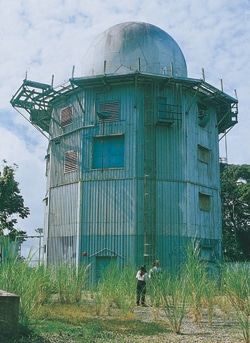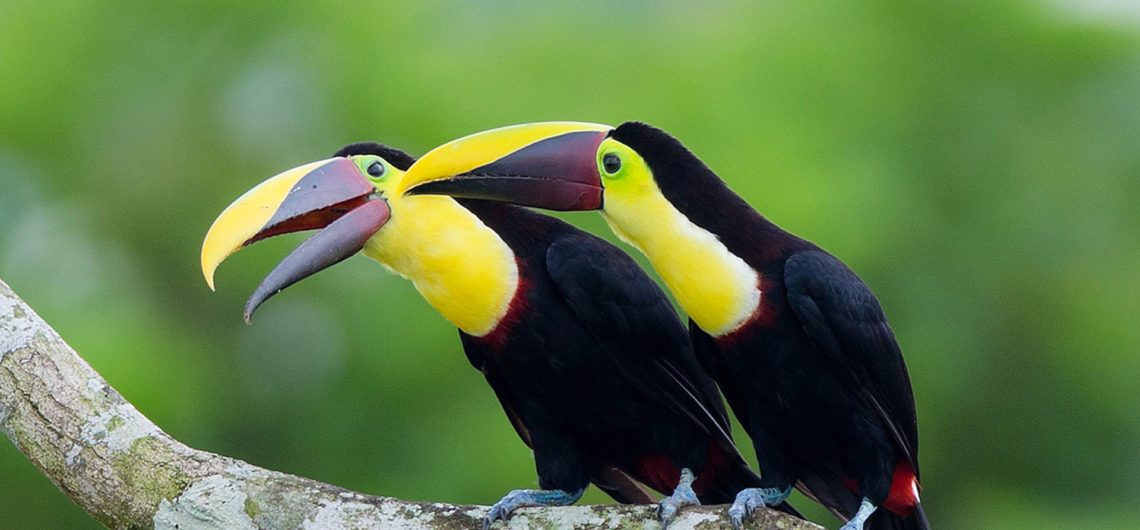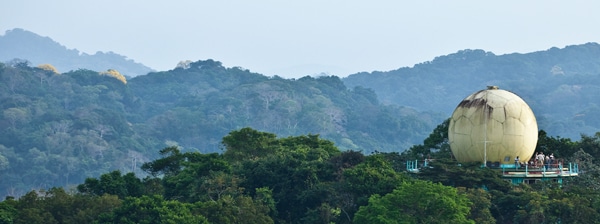The Canopy Tower
A Pilot Project of the TCR Alliance
TCR Strategic Alliance: Tourism, Conservation, Research
International Conference on Heritage Tourism for the Next Millenium
Hotel Miramar, Panamá, December 2, 1998
Raúl Arias de Para

I have a confession to make.
On August 22, 1996 I fell in love with a building. It was not a regular run of the mill glass and concrete building; it was a steel structure, a radar tower built by the United States Air Force in 1965. It was not a spring chicken either. How can anybody in his right mind fall in love with this metal structure that looks so forbidding and which has been described by some people as resembling a gigantic beer can?
It defies logic. In any event, it was love at first sight not only with the tower but also with its location, right in the center of Soberanía National Park.
As with all relationships based on first impressions, there was a lot of imagination involved.
I imagined the view from the top would be fantastic and it is! You can even see ships traversing the Culebra Cut, the narrowest part of the Panama Canal.
I imagined it would be easy to see beautiful birds and mammals and I turned out to be right.
I imagined I could transform the tower into a unique lodge with rooms opening at the level of the treetops and I did.
This metamorphosis from an abandoned radar tower to a mini-lodge took two years, lots of money and more sleepless nights than I care to remember. I call it the ultimate recycling project, from a military installation to a bird watching center…and what can be more peaceful that bird-watching?
The biblical passage of turning swords into plowshares acquires a new meaning and it is represented perfectly in this case. It also shows that we, Panamanians, are perfectly capable of utilizing in a rational, sustainable manner the properties being transferred to us by the US government in compliance with the Torrijos-Carter Treaties. In particular, those properties located in the vital watershed of the Panama Canal.
Sometime during this metamorphosis along came a lady from the United States, our dear friend Hana Ayala with her revolutionary ideas about linking tourism with conservation and research.
I had always thought that ecotourism should be and instrument of conservation, more than an end in itself. But Hana went farther: tourism in general, the biggest and wealthiest industry in the world, should be a patron of conservation and research, two activities that are essential for human development in its broadest sense, but that are usually short of funds. And this link would not be merely because of civic-minded reason but because it is also good business. Needless to say, I readily enlisted in her crusade to transform tourism in Panama and here I am enthusiastic proponent of this new strategy.
And what is the role of The Canopy Tower in conservation and research?
We are located deep within Soberanía National Park, at the entrance of Old Plantation Rd. This is an easy graded dirt road that passes through a mature forest for about four miles connecting to the legendary Las Cruces Trail.
It is called Plantation Road because it used to lead to a cacao plantation owned by the Panama Canal Company in the early days of the former Canal Zone, more that 50 years ago. You can still see some of the old cacao trees with their peculiar fruit growing straight from the trunk. It is hard to believe that the elegant, gold plated boxes of Lady Godiva chocolates come from this humble tree. This is also one of the best areas in Panama for bird-watching and hiking through the rainforest.
We are committed to keeping this road clean and to helping in its surveillance, helping the park rangers of the environmental authority, which, unfortunately, total only 8 for an area of 20,000 hectares, approximately 43,000 acres.
To help us in this task we have an unexpected ally, a former poacher who is now in our staff and who knows the forest as well as the palm of his hand. He is also a great guide, for he knows the behavior of animals very well and has a particularly uncanny ability to spot them within the dense foliage of the underbrush.
Perhaps his eyesight is so good because he did not spend his childhood days glued to a TV screen!
His name is Segundo; we call him the “eco-poacher”, a perfect oxymoron.
The Canopy Tower is also one of the observation points from which Dr. George Angehr of STRI, in collaboration with Dr. Sid Gauthreaux of Clemson University and with the support of the U.S. Department of Defense Legacy Program, is monitoring the migratory hawks and vultures that pass through Panama every year.
Virtually the entire North American populations of these species, the Turkey Vulture, Broad-winged Hawk, and Swainson’s Hawk, numbering millions of birds, pass through the isthmus en route between their breeding grounds in North America an their wintering grounds in South America.
These birds rely almost entirely on soaring, rather than flapping, during their migration. They take advantage of the rising warm air currents, thermals, produced by the sun’s rays during the day in order to gain elevation. Then they glide for many miles, slowly losing altitude, before they need to find another thermal and rise again. By this means they are able to complete a migration of many thousands of miles expending very little energy.
Because these birds require rising warm air to soar, they are unable to migrate at night or on rainy days. At these times they require roosting sites in the forest to rest. One of the objectives of this study is to determine the importance of the existing forest of the Panama Canal Area as overnight roosting sites for these migratory birds.
The actual count is dome by expert bird watchers from the Panama Audubon Society and the University of Panama, who have been trained by Dr. Angehr. Guests of the Canopy Tower will be invited to participate. This study will contribute valuable information on the population sizes of migratory raptors as well as the value of Canal Area forests in the preservation of the world’s biodiversity.
In closing, I would like to add two comments:
First, I must thank my wife Denise for believing in this project from one, actually for believing in my dreams and me.
I would also like to invite you all to come and visit the Canopy Tower and fall in love with it. I am not jealous.
Thank you very much.


